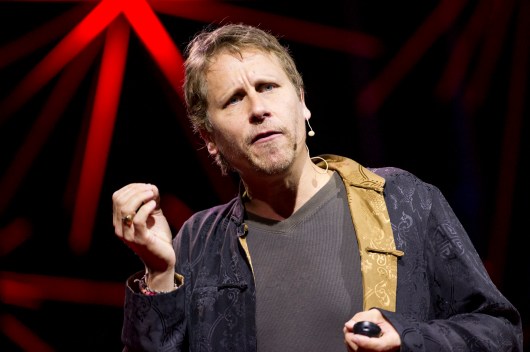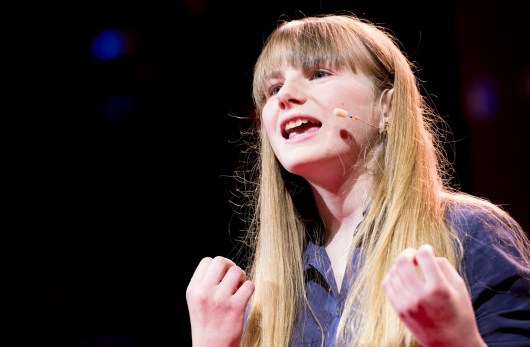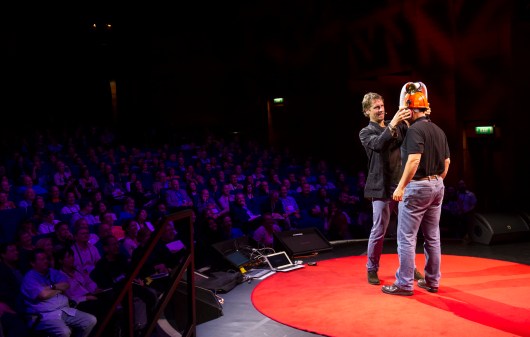Science and perception
Beau Lotto starts with a game. He asks the audience, “Read what you see,” and he shows what looks like words with holes missing. Wh a e ou rea in ? The audience reads whole words (What are you reading?), but Lotto points out we’re not really reading the letters. Instead we’re “seeing what is useful to see, based on what we’ve seen in the past.”
The question, he says, is how can we see past our previous perceptions? Nature’s solution is play, and he defines play with five ways of being:
- Celebrating uncertainty.
- Adaptable to change.
- Open to possibility.
- Cooperative.
- Intrinsically motivated.
And, says Lotto, this is what defines science itself. As he says: “Science is not defined by the method section of a paper, it’s a way of being.”
Who can do science?
How universal is this view; can science only be done by a few experts or by anyone. Well, asks Lotto, “Who better to ask than 25 8- to 10-year-old children? They’re experts in play.”
He asked 25 students from Blackawton Primary School to come up with research questions — real research questions, the anwers to which were not known ahead of time. Thus was born the Blackawton Bees Project.
He introduces Amy O’Toole, the youngest published scientist in the world, to introduce the question that she came up with.
Says O’Toole, “We thought that it was easy to see the connection between humans and apes … but it would be amazing if humans and bees thought in the same way.” Do bees solve complex problems in the same way that humans do? Can bees adapt to new situations?
Lotto takes back the stage to move on to the next step: to design an experiment, “which is a game.” If you’re going to do an experiment on bumblebees, you have to create a game. So the kids created a puzzle for the bees. O’Toole describes the experiment: “We created a game that was an if-then rule. We asked if the bees could learn to go to a certain color flower if they were in a certain pattern. They should only go to yellow flowers if they’re surrounded by blue ones.” So, how would they solve the puzzle? “The exciting point,” says Amy with a huge smile, “is that no one had done it before, including adults.”
The first scientific paper by 10-year olds
Lotto resumes, saying the next step is observation. He shows a video of the kids doing the experiment, and then moving on to the final step, sharing. In this case, writing a paper. Of course, “The best place is in a pub.” (Laughter, as they see Lotto’s beer by the kids’ sodas.)
At the pub, they wrote a paper — the students wrote a paper. In true kid fashion, it starts, “Once upon a time.” They submitted it to two journals. It was rejected by one (one reason for rejection: The figures were in crayon) but accepted by another, to glowing reviews. It is the first paper by primary school kids, making Amy and her friends the youngest published scientists in the world. It’s been downloaded over 30,000 times, and was an editor’s choice in Science Magazine.
Download and read their paper here >>
Lotto brings us to the point: “We normally walk through life responding. If we ever want to do something different, we have to step into uncertainty…. Science lets us step into uncertainty through the process of play.”
Beau Lotto demonstrates a perception game on fellow Session 3 speaker Shimon Schocken.
To finish, we hear a final comment from O’Toole: “A small question can lead to a big discovery. Changing a way a person thinks about something can be easy or hard, but it all depends on how the person thinks of thinking.” And she has learned that “Science isn’t just a boring subject, and anyone can discover something new, you just need an opportunity.”
Watch Beau Lotto’s previous TEDTalk >>
Photos: James Duncan Davidson



Comments (6)
Pingback: How to Teach Preschool Science | rightfromthestart
Pingback: Young musicians who’ve shared a stage with their idols - Entrepreneur News | Australian Society of Entrepreneurs
Pingback: Beau Lotto’s TEDTalk & more: links « DCSZ TOK Class Blog
Pingback: Young musicians who’ve shared a stage with their idols « Content Curated By Darin R. McClure & a few photos
Pingback: The magic of a group think: TEDGlobal 2012 Day 1 recap « Content Curated By Darin R. McClure & a few photos
Pingback: atomia-site-title